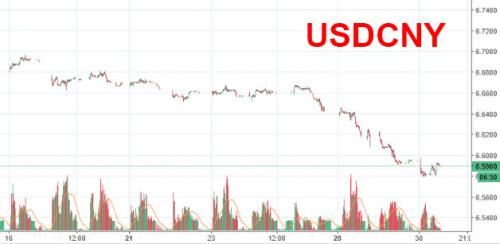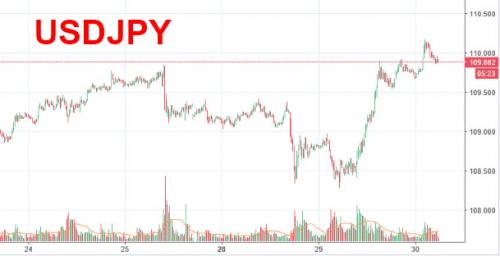S&P futures are higher in early Wednesday trading, alongside Asian stocks and European bourses, both solidly in the green as the EUR/USD drifts below the 1.20 “redline” while the dollar rebounds off a two and a half year low following the US “measured” response to North Korea’s missile test, which soothed jittery investors who now turn their focus to US economic data. Equity indexes in Japan, Hong Kong, and South Korea also rose while 10Y US Treasuries are steady before the release of ADP employment and GDP data, both of which are expected to show an increase. The VIX is down fractionally to 11.60.
European stocks rose higher, tracking counterparts in Asia and the United States and reversing losses from the day before when investors were spooked by Pyongyang’s firing of a ballistic missile over Japan. Fears that this could trigger an aggressive response receded on Wednesday after the United Nations – in a statement drafted by the United States – condemned North Korea’s latest missile launch but held back any threat of new sanctions.
Trump, who previously vowed not to let North Korea develop nuclear missiles that can hit the mainland United States, said the world had received North Korea’s latest message “loud and clear”.
“Instead of the (U.S.) President responding to the escalation via Twitter, as has happened on many recent occasions, the White House issued an official statement to condemn the action,” said IronFX analyst Charalambos Pissouros. “This may have been interpreted by investors as a sign that the US will approach the situation in a more measured and diplomatic manner, as opposed to raining down ’fire and fury’.” North Korean media reports on the launch also lacked their usual claims of technical advances, indicating the test may not have succeeded as planned.
Boosted by this optimism from Trump’s response, European markets rebounded after yesterday’s U.S.-led unwind of the North Korea related risk-off move. DXY holds at overnight strongest levels; AUD marginally outperforms after solid construction data; USD/JPY briefly traded above 110.00 through the European open which also provides a lift to U.S. equity futures.

In Europe, the pan-European STOXX 600 gained 0.5%, recovering nearly all the ground lost in the previous session and banking stocks – which had led the risk-averse move lower on Tuesday – were up nearly 1 percent, while the utilities sector lags after France warns on eventual closure of nuclear plants. European strength emerged after the stronger dollar pushed the EURUSD off the 1.20 led, trading below 1.950 last. The U.K.’s FTSE 100 Index increased 0.2%. Germany’s DAX Index rose 0.4 percent, the largest advance in more than a week.

European upside followed gains in Asia, where MSCI’s broadest index of Asia-Pacific shares outside Japan rose 0.6% while Japan’s Nikkei rose 0.7%. The Hang Seng Index rose 1.2%, closing above 28,000 for the first time in two years as concern over North Korea tensions waned and China Shenhua Energy led power producers higher, while banks rose ahead of earnings results. The Shanghai Composite Index fluctuated before edging lower. The MSCI Asia Pacific Index rose 0.2 percent.
The Chinese currency extended a surge that made it Asia’s best performer this month, rising to its highest level since June 2016 amid a weak dollar, following 11 consecutive days of increases in the offshore CNH. The CNY strengthens 0.05% to 6.5923 per dollar as of late afternoon trading in Shanghai in fourth day of gains; the currency has climbed 2.1% this month. On Wednesday, the PBOC strengthened the yuan reference rate for the third day, raising it by 0.29% to 6.6102, meanwhile the Bloomberg replica of CFETS index, which tracks the yuan against 24 currencies, climbed 0.37% to 94.0325, highest since Aug. 11

Meanwhile, Bund futures edged higher as German regional CPIs indicated a national reading broadly in-line with consensus, German and U.K. curves slightly steeper. Euro zone government bond yields, which fell to fresh lows on Tuesday, edged up on Wednesday as forecast-beating inflation in Spain was expected to be followed by similar data in Germany, defying the euro’s recent strength. The yield on 10-year Treasuries climbed less than one basis point to 2.13%. Germany’s 10-year Bunds increased one basis point to 0.35%, while Britain’s 10-year yield gained two basis points to 1.019%, the largest advance in more than a week.
In commodities, gasoline hit a two-year high, rallying another 2.8%, after Hurricane Harvey shut down nearly a fifth of U.S refining capacity, and more closures are expected.
However, the rising crude inventories as a result of refinery shutdowns, weighed on oil prices. U.S. crude futures fell 0.6 percent to $46.17 a barrel, after touching a five-week low on Tuesday. Brent slipped 0.6 percent to $51.67. Spot gold edged marginally lower to $1,309.39 an ounce on Wednesday. On Tuesday, the precious metal jumped to its highest since Trump was elected U.S. president.
Economic data include second print on GDP growth, weekly MBA mortgage applications and August ADP employment. Analog Devices Inc. and Workday Inc. are among companies reporting earnings.
Bulletin Healine Summary from RanSquawk
tensions
110.0, although under now














Leave A Comment